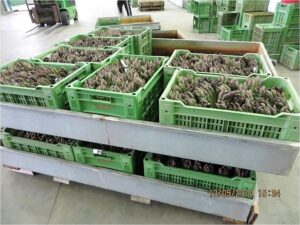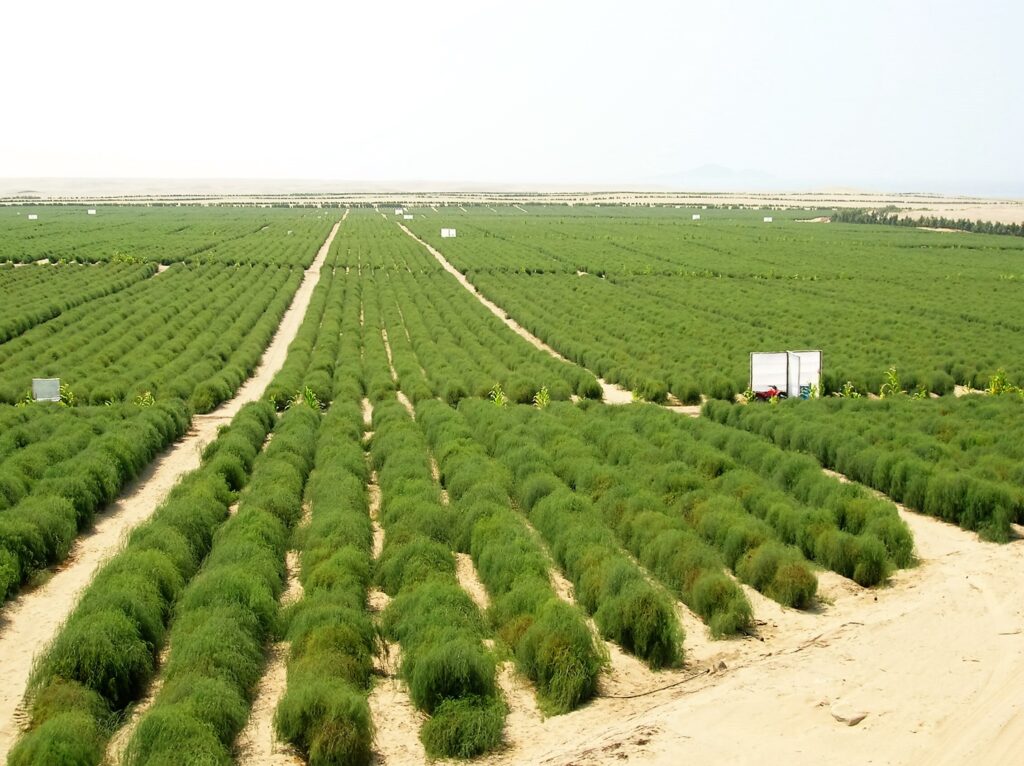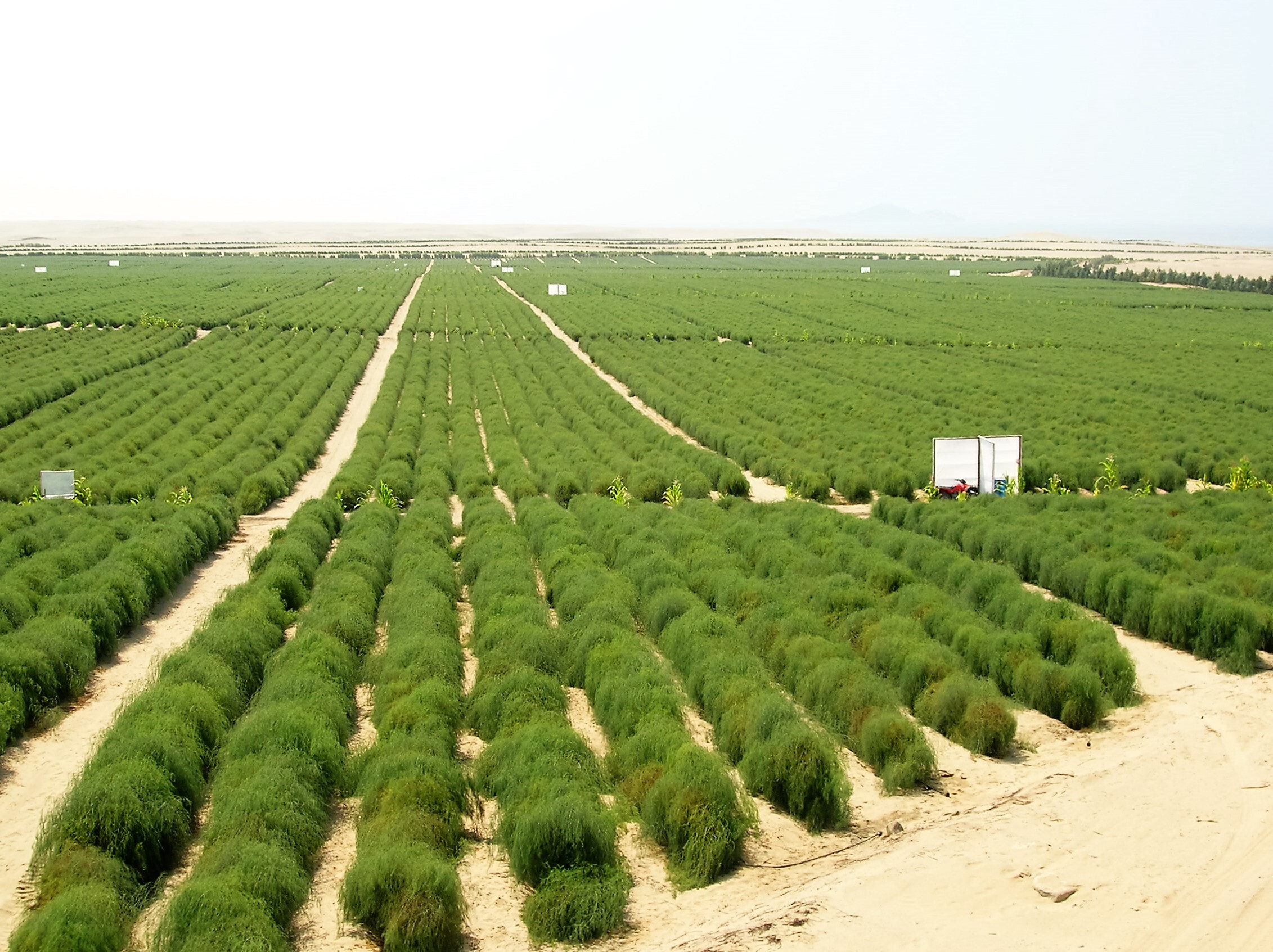Is asparagus emerging from the crisis?
Asparagus can be grown almost anywhere in the world, in many climates and sometimes in very different soils. Its good preservation, the maintenance of its taste qualities and, above all, the added value that this vegetable generates throughout its production and distribution chain have turned it into a “globalised” crop in the same way as certain fruits such as banana, avocado, mango, kiwi, apple and, more recently, blueberry. It is an example of intercontinental trade in vegetables.
The “globalisation” of trade flow

The end of the last century saw steady growth in asparagus production around the world. From 140,000 ha in 1988, world production crossed the 200,000 ha mark just before entering the new millennium. Then it continued to progress up to 280,000 ha. The expansion of planted area has mainly occurred thanks to the emergence of new production areas, such as Peru and Mexico. Until then, asparagus was mainly grown in the countries where it was consumed, but it has taken off in countries where agronomic conditions were favourable to it and, above all, where labour is inexpensive. The “globalisation” of the flow of goods (by sea and air) and new transport technologies (containers) have led to the intensification of trade. Currently, global asparagus production spans 190,000 ha across four major production areas.
“Luxury product” in Japan
Asia grows asparagus on over 59,000 ha, with China alone accounting for 47,000 ha. China’s production is 70% white asparagus and 30% green asparagus and it has diverse end markets: 60% for preservation, 30% for the fresh market and 10% frozen. It is the world’s largest producer of canned asparagus. With a much smaller area (7,000ha), Japan is the other country in Asia where asparagus is a traditional crop. In Japan, Asparagus is sold for the fresh market with high added value and seen almost as a “luxury product” (see Asparagus World n°5/2023). Thailand and the Philippines have modest but stable production areas of about 1,600 ha of 100% green asparagus. Taiwan is focused on the fresh white asparagus market (90%). In this part of the world, Australia (2,000 ha) and New Zealand (1,000 ha) grow green asparagus, principally for their own domestic markets.
Peru’s weak point vis-à-vis Mexico
On the American continent, the predominantly green asparagus production of the countries of the North – the US (8,000 ha) and Canada (2,000 ha) – pales in comparison with that of Mexico (32,000ha). Climatic conditions, labour costs and proximity to the lucrative North American market are the factors driving the growth of Mexican asparagus, which continues upward. (See World Asparagus n°1/2019). Further south, Peru (18,000ha) is the largest asparagus-producing country in Latin America. It is one of few countries – along with its smaller neighbours, such as Ecuador (2,000 ha) and Colombia (800 ha), but also Thailand – that is able to grow asparagus year-round. Peru’s production is spread across green (60%) and white (40%) asparagus. The canned goods market is its largest outlet (50%), followed by the fresh (40%) and frozen (10%) markets (see Asparagus World n°3/2021 & n°4/2022). But the distance to the North American market (9+ days by sea) and very expensive air freight are weak points in relation to its main competitor, Mexico, which has gained a lot of market share. In the past 15 years, the economic situation has forced Peru not only to reduce its acreage but to shrink its production schedule by two months and stop exports in January and February. As a result, Peru has lost its position as the world’s leading asparagus-producing country. Chile (2,000 ha) is a dynamic market with green asparagus areas mainly oriented towards supplying the frozen segment (60%). On the same continent, Argentina (1,000 ha) (see Asparagus World n°6/2024), Brazil (800 ha), Guatemala (500 ha), Uruguay and Nicaragua (200ha), are also asparagus-producing countries.
Attempts that did not endure
Asparagus production is almost absent from the African continent (3,700 ha), with rare exceptions in the North and South. South Africa has the largest asparagus area (1,500 ha) focused on white asparagus production (80%), most of which goes to canneries (60%). The production of fresh asparagus finds its outlets on the domestic market as well as for export, particularly to Japan. Lesotho (see Asparagus World n°6/2024) and Kenya are also asparagus-producing countries. In North Africa, Morocco (500 ha) and Tunisia (200 ha) have hosted projects often led by European companies attracted by labour costs and precocity. In many cases, these attempts have not proved sustainable in the long run.
Europe invests its hopes in innovation
Europe is the botanical and historical cradle of asparagus production (58,000 ha). This is very clearly split between the production and consumption of green asparagus in the Mediterranean (Spain, Italy) and Anglo-Saxon (UK) countries and white asparagus production on Continental Europe (Germany, France, the Netherlands). Asparagus production in Europe is exclusively for the fresh market. In terms of surface area, Germany is the leading producer (18,000 ha), mainly of white asparagus. Spain (12,000 ha) and Italy (10,000 ha) are very much oriented towards the cultivation of green asparagus. Then comes France (6,000 ha), which produces white asparagus (70%) though is seeing growth in green asparagus (30%), then the Netherlands (3,000 ha) 100% white asparagus, and the UK (2,500 ha) 100% green asparagus. There is also white asparagus production in Poland (2,000 ha), Austria (800 ha), Belgium (700 ha), Hungary (500 ha). The general trend in European production is towards a decrease in surface area, particularly in Germany (see Asparagus World n°5/2023) and the Netherlands but also in Spain and Italy. The surface area is shrinking due to the lack of profitability of the crop, which is very much affected by the rising cost of labour, but also by a decrease in consumption. More recently, the effects of climate change and reduced water availability are also limiting renewal and new plantings in Mediterranean countries. To stay competitive, Europe has relied on technological innovation. It has developed very productive varieties and gained precocity by using plastic covers. European producers are trying to reduce their production costs by developing the mechanisation of cultivation and the robotisation of harvesting.
Signs of emergence from crisis
This world tour of asparagus-producing countries can be summed up as “producer/consumer countries” that have reduced their surface area. And “producer/exporter countries” that expanded them. The competitiveness of each of these is constrained by the cost of labour, the cost of getting to market (logistics) and by the sales price. The cost of labour is a parameter that is constantly increasing (see box). The availability of asparagus around the world plays a role in market fluctuations. By analysing the evolution of asparagus areas and world prices, Christian Befve, an international consultant, notes that when the world asparagus production passes the 240,000 ha mark, prices are destabilised and the market enters a crisis situation. “This is the situation that the asparagus world has just experienced over 2014-18 with a strong increase in global surface area, from 210,000 ha to 280,000 ha over this period, leading to stagnation and a fall in prices, then to a phase of grubbing up and regression of areas,” he says. Since 2022, when the global surface area fell below 200,000 ha, there has been an increase in world asparagus prices. “Does this signal that we are starting to emerge from the global asparagus crisis?” the expert wonders.
It takes over a kilo of asparagus to pay for an hour of work
In a comparison between the number of kilos of asparagus (at the farmgate price) needed to pay for an hour of harvesting work in France and Peru, data provided by international consultant Christian Befve shows they have grown in parallel. For example, in 2005, it took 2 kg of asparagus to pay for one hour of work in France but just 1.3 kg in Peru. By 2025, the gap between the origins will have widened, to 2.5 kg in Peru and more than 4 kg in France.
























